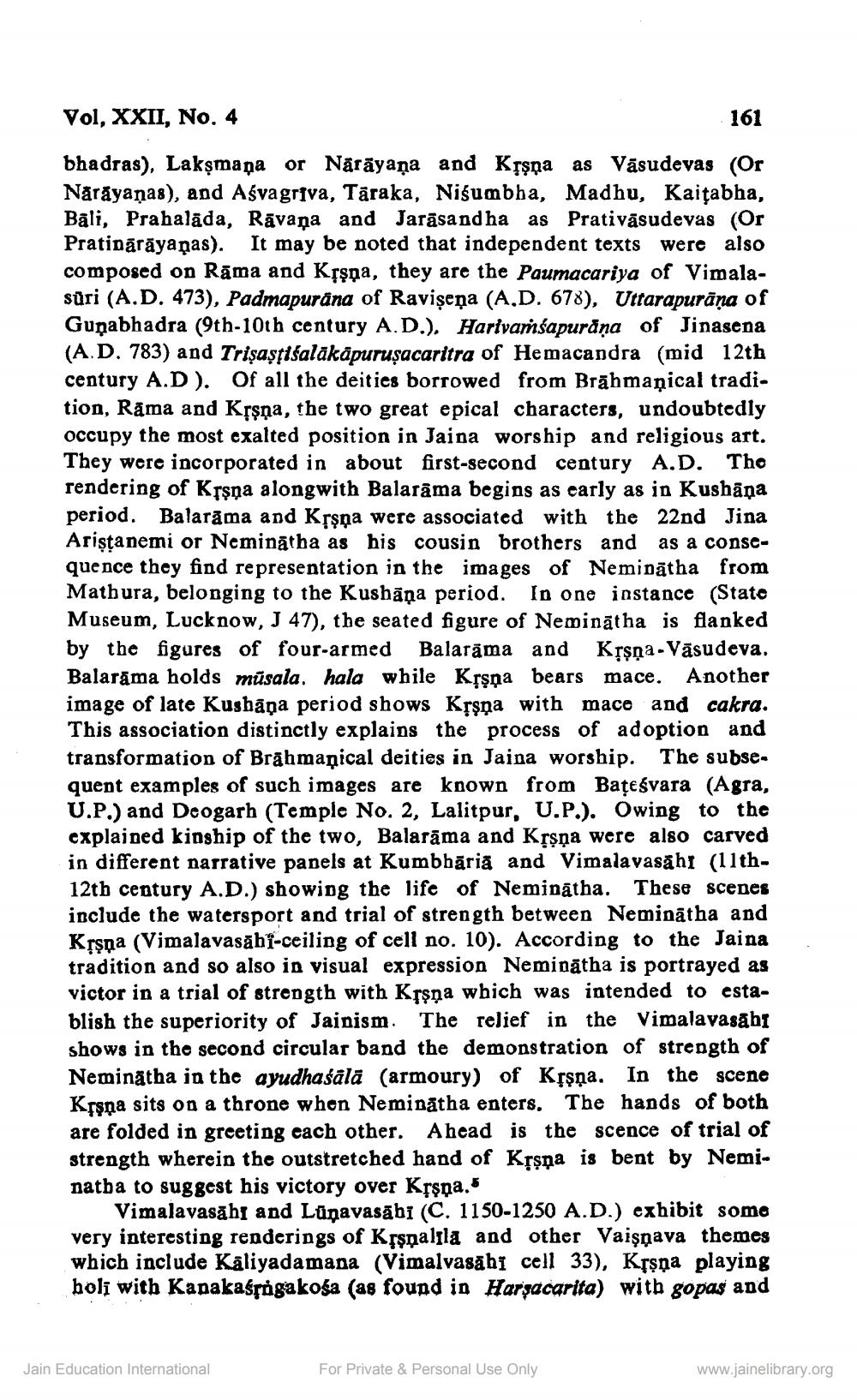________________
Vol, XXII, No. 4
161
bhadras), Lakşmaņa or Nārāyaṇa and Kļşņa as Vāsudevas (Or Narayaņas), and Ašvagriva, Tāraka, Nisumbha, Madhu, Kaitabha, Bali, Prahalāda, Rāvana and Jarāsandha as Prativasudevas (Or Pratinārāyanas). It may be noted that independent texts were also composed on Rāma and Kệşpa, they are the Paumacariya of Vimalasüri (A.D. 473), Padmapuräna of Ravişeņa (A.D. 678), Uttarapurāņa of Gunabhadra (9th-10th century A.D.). Harivarśapurăņa of Jinasena (A.D. 783) and Trișașsisalākāpuruşacaritra of Hemacandra (mid 12th century A.D). Of all the deities borrowed from Brāhmaṇical tradition, Rāma and Kļşņa, the two great epical characters, undoubtedly occupy the most exalted position in Jaina worship and religious art. They were incorporated in about first-second century A.D. Tho rendering of Kșşņa alongwith Balarama begins as early as in Kushāņa period. Balarama and Krşņa were associated with the 22nd Jina Aristanemi or Neminātha as his cousin brothers and as a consequence they find representation in the images of Neminātha from Mathura, belonging to the Kushāna period. In one instance (State Museum, Lucknow, J 47), the seated figure of Neminātha is flanked by the figures of four-armed Balarama and Kļşņa-Vasudeva. Balarama holds mūsala, hala while Kțşņa bears mace. Another image of late Kushāna period shows Krsna with mace and cakra. This association distinctly explains the process of adoption and transformation of Brāhmanical deities in Jaina worship. The subsequent examples of such images are known from Bateśvara (Agra, U.P.) and Deogarh (Temple No. 2, Lalitpur, U.P.). Owing to the explained kinship of the two, Balarama and Kțşņa were also carved in different narrative panels at Kumbhāriã and Vimalavasahi (11th12th century A.D.) showing the life of Neminātha. These scenes include the watersport and trial of strength between Neminātha and Krsna (Vimalavasāhi-ceiling of cell no. 10). According to the Jaina tradition and so also in visual expression Neminātha is portrayed as victor in a trial of strength with Krsna which was intended to establish the superiority of Jainism. The relief in the Vimalavasabr shows in the second circular band the demonstration of strength of Neminātha in the ayudhaśālā (armoury) of Kļşņa. In the scene Kțşņa sits on a throne when Neminátha enters. The hands of both are folded in greeting each other. A head is the scence of trial of strength wherein the outstretched hand of Krsna is bent by Nemi. natba to suggest his victory over Kțşņa.5
Vimalavasāhs and Lūnavasābi (C. 1150-1250 A.D.) exhibit some very interesting renderings of Krşnalıla and other Vaisnava themes which include Kaliyadamana (Vimalvasabi cell 33), Kţşņa playing boli with Kanakaśpigakośa (as found in Harşacarita) with gopasi and
Jain Education International
For Private & Personal Use Only
www.jainelibrary.org




